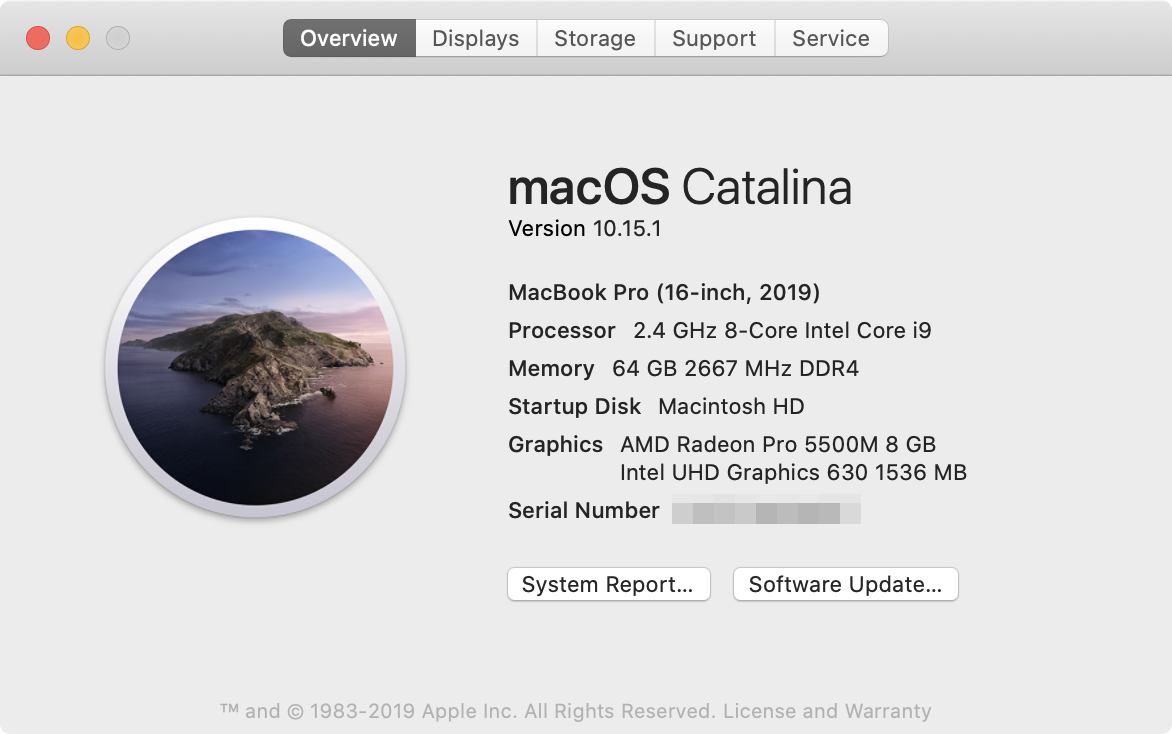
I’d like to tell you about the new 16″ MacBook Pro in a way that doesn’t repeat what everyone else has had to say already. I think I have a way to connect the dots between the new MacBook Pro and the tour we had of SpaceX. We’ll get to that in a bit.
I got the new hotness on Tuesday, two days ahead of the earliest date Apple said it would arrive. I decided to do a clean install of all my applications and data, even though I just did a clean install on my 2016 MacBook Pro a month and a half ago. I probably could have used Migration Assistant and not have too much cruft. The desire to have a super clean system won the argument. I find it very pleasing when talking to AppleCare to say, “this was a CLEAN INSTALL!”
I dragged over my data from my backup drive and installed every single app by scratch and did every fiddly bit of tailoring all by hand. Since I did it so recently, it only took me about a day and a half to get everything working exactly as I like it. I have to tell you, having that mind map of what’s mission-critical, important, and less important was awesome. I attribute the mind map to why it took so little time.
Another time-saver was I used Knightwise’s tip from last year on how to install Mac App Store apps from the command line. That put 28 apps on my Mac with no intervention by me at all. Very cool.
Let’s talk about the new machine now.
Keyboard
I wrote a piece on the butterfly keyboard in which I said it wasn’t accurate to say it was a bad keyboard because the goodness of a keyboard is a matter of opinion. Of course, the fact that they broke pretty often on people might make the moniker of “bad” appropriate, but the way it feels is neither bad nor good.
I can prove that statement by saying that I prefer the butterfly keyboard on my older MacBook Pro to the “new and improved” scissor key version on the 16″. The new one is mushier and less clicky which disappoints me. Many people (including Apple during their briefing to a select few) said it was the Magic Keyboard with a few improvements.
I love the Magic Keyboard and use it every day at my desk. The keyboard on the 16″ might look a lot like the Magic Keyboard in size of keys, key separation, and the throw of the keys, but it does not feel like the Magic Keyboard. But hey, it’s a lot quieter than the old keyboard so it doesn’t sound like you’re typing a manifesto when writing a love note to your sweetie.
I’m sure I’ll get used to the new keyboard, and I hope the people who have been harping on the keyboard incessantly for the last three years will finally be happy. I’m sure they’ll find something else to be annoyed about though.
Size
I’m also a little bit bummed that it’s actually bigger than the 15″ MacBook Pro. Sure, it’s got a 16″ screen, but the 15″ was really 15.4″ so it’s hardly noticeable. I was expecting thicker since the keys have more throw, but they decided to pack in more battery too so it’s heavier. It’s also deeper from front to back.
Most people wouldn’t notice it, but that little smidge deeper means that my left arm is now suspended on the case by my watch. The 2013 was like that but the 2016 was that little bit shorter from the front of the device to the front of the keys. Again, it’s not a huge deal but I may have to go back to taking my watch off when I’m typing on it away from my desk.
To be specific on the size, the 16″ is 10% bigger in volume and 7% heavier. All of you happy 13″ MacBook Pro and MacBook Air owners may look longingly at my giant, beautiful screen but at 4.3 lbs, I bet you’re not jealous of having to lug that weight around!
I put a few photos into the show notes so you can visualize the size difference between the previous model 15″ and the new 16″.
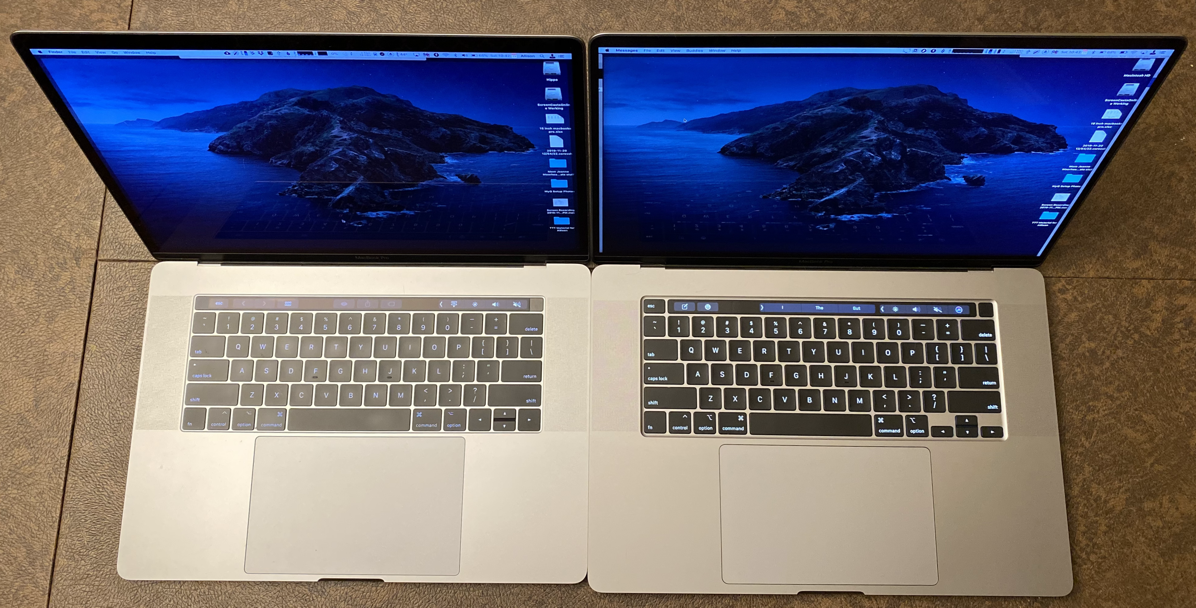
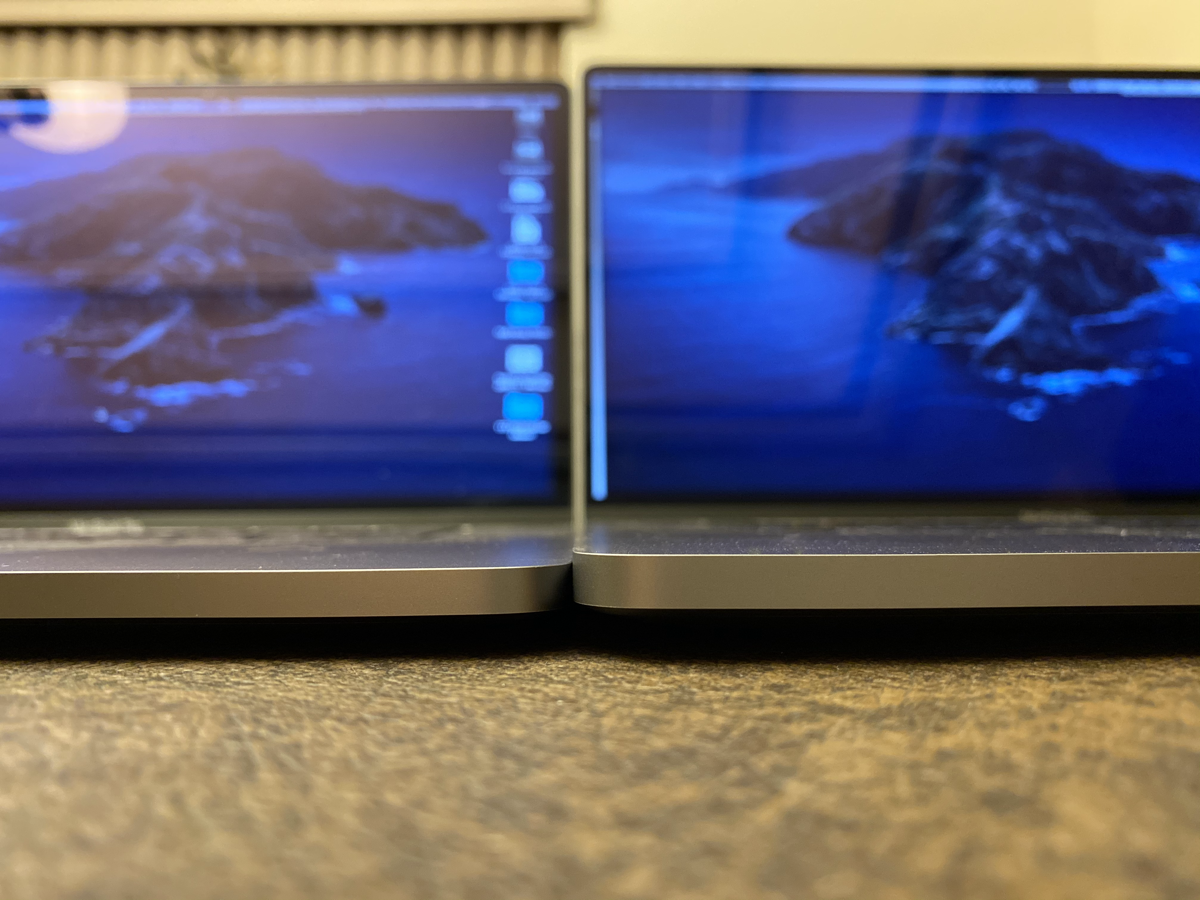
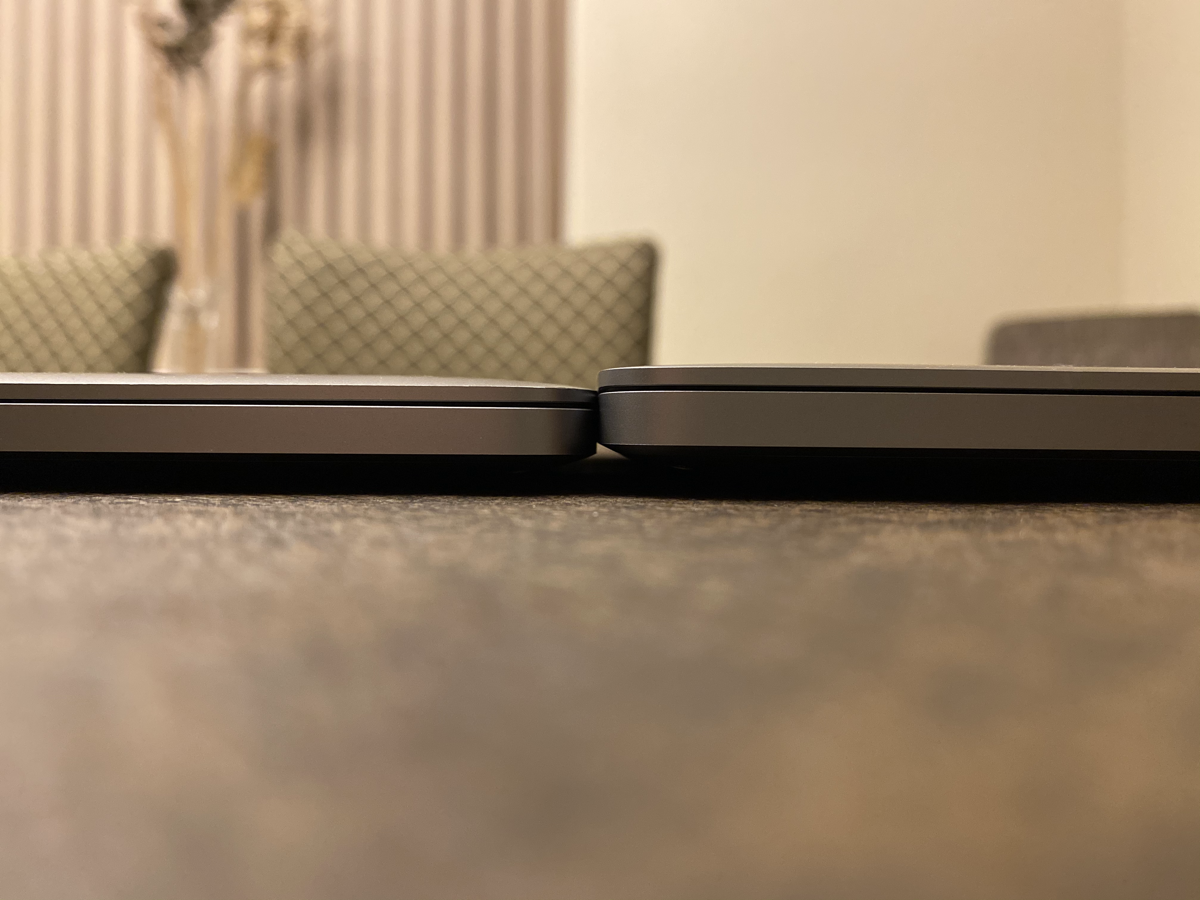
Speed
Ok, enough whining, let’s get to the awesome part! This thing is fast! I went for top of the line in speed and graphics and RAM: 2.4GHz 8-core i9 with 64GB of RAM, but I held strong and only got 4TB of disk. I talked about what I can do with this much RAM in our Dumb Question about insane amounts of RAM so I won’t repeat it here.
When I got the 2016 MacBook Pro, I measured the speed against my 2013, and I was unable to find a single thing I do in which I could actually measure any difference in speed. But going from the 2016 to 2019 16″ the difference is definitely measurable.
Every week I record Chit Chat Across the Pond into a digital audio workstation application called Hindenburg Journalist. A typical file is around 750MB when I’m done. I then export the file out to a 64Kbps mono m4a file. The compression gets it down to 130MB.
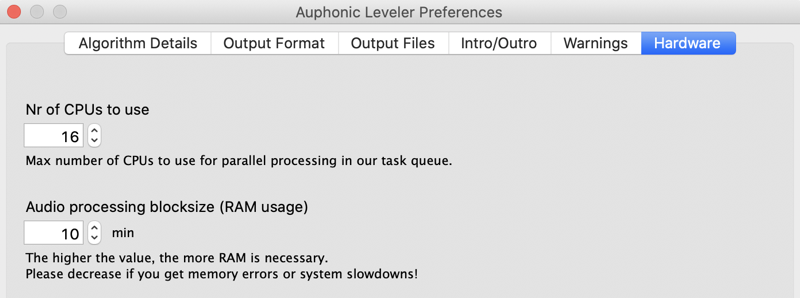
From there I run the m4a file through Auphonic Leveler on my desktop to level the audio, raise it to the loudness standards, and then export from there to a compressed 64Kbps mp3. The final file is around 30MB.
I tested the process and the new Mac transcoded the m4a file out of Hindenburg 42% faster than the 2016. That isn’t going to be a huge time saver, because it only took 23.5 seconds on the old Mac! But the transcoding and leveling in Auphonic take over 2 minutes, and I was able to measure a 23% improvement in speed.
Auphonic actually has a section where you can tell it the number of CPUs to use, so I was able to dedicate all 16 (8, dual-core processors) to the task, doubling what the 2016 could use. There’s also a section where you can define the audio processing block size which is related to RAM usage. I’m not entirely sure what this means, because the value can be from 1-10, and it says “min” next to it. I think that stands for minimum maybe? But what is 1-10? The only other clue is it says “The higher the value, the more RAM is necessary. Please decrease if you get memory errors or system slowdowns!” I interpret that to mean if I have more RAM available, I might as well set this to 10, so I did. The tests were impressive so I guess it works.
Let’s take it up a notch and throw some video at the two machines. Three years ago, I was really most surprised that the 2016 wasn’t faster than the 2013 in transcoding a Screenflow video tutorial out to an mp4 file. This year I’m not disappointed, the 16″ beat the older Mac again by 42%, dropping the time to transcode a 45 minute, 1GB file from around 11 minutes down to just under 6.5 minutes.
I don’t actually transcode my own videos, as Don and his team do that after all their edits, but I’m expecting as I do my next video tutorial to see it respond faster as I’m working as I’m editing in ScreenFlow. There are lots of times where the audio waveform doesn’t show up for a while after an edit because the machine is churning away figuring out how to draw it. Hopefully, that problem will go away.
In a more qualitative sense, a few things feel way faster. Some apps are definitely launching faster. Hindenburg in particular just blinks on – it used to take a couple of heartbeats to open. Touch ID seems significantly faster too. I complained to Dave Teare of AgileBits at Macstock that the time for 1Password to recognize Touch ID was really long. Well, it isn’t anymore! Ejecting my backup drive using Parallels Toolbox is instantaneous now. I know it was just a few seconds to eject on my old Mac but it felt interminable to me, and I confess I’d often just yank it out because it was taking too long.
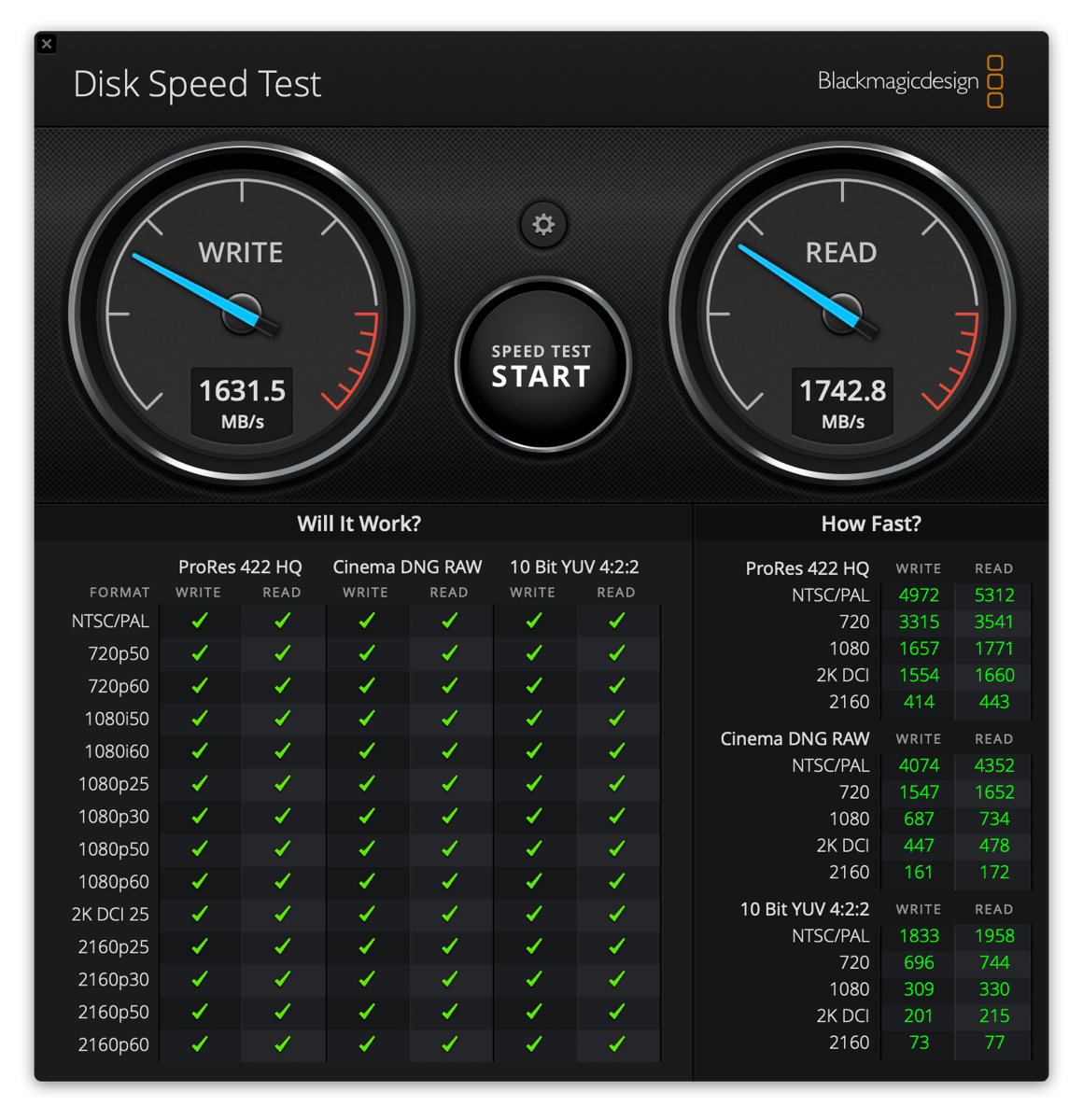
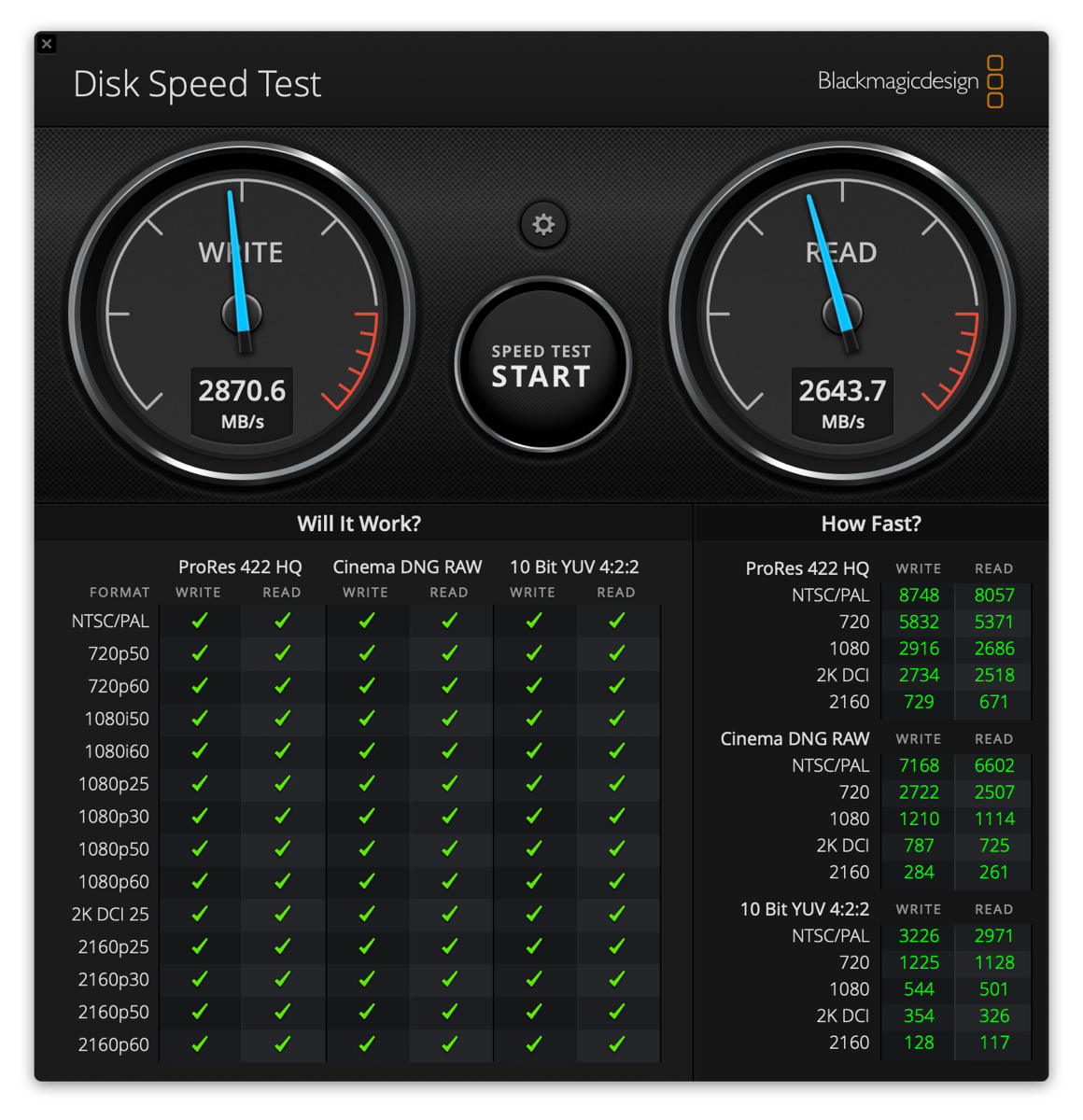
Because it’s a thing we do, I ran the Blackmagic Disk Speed Test on both Macs. The original purpose of this free testing application was to determine if your disk was fast enough to record to real-time in all kinds of formats and resolutions. For a long time, SSDs have been fast enough for all the tests, but it’s super fun to run and watch the little meter go up. The new 16″ MacBook Pro performed writes at 3000MB/s write and reads at around 2600MB/s. It beat my 3-year old Mac by 45% in writes and 34% in reads. Not sure I’ll notice that because I never seem to wait for something to write to disk, but I feel good looking at the numbers!
I was noodling these numbers with my buddy Steven Goetz in Canada and he ran the same tests on his 13″ MacBook Pro with Touchbar from 2018. You would think that his 2018 machine would be really close in disk speed to the 2019 machine, and you’d be half right. His 13″ MacBook Pro as measured by Blackmagic that is only 3% slower than mine in reads. But his write speed is 57% slower. This is where things get really interesting and will take us down a geeky path that will mystify David Roth.
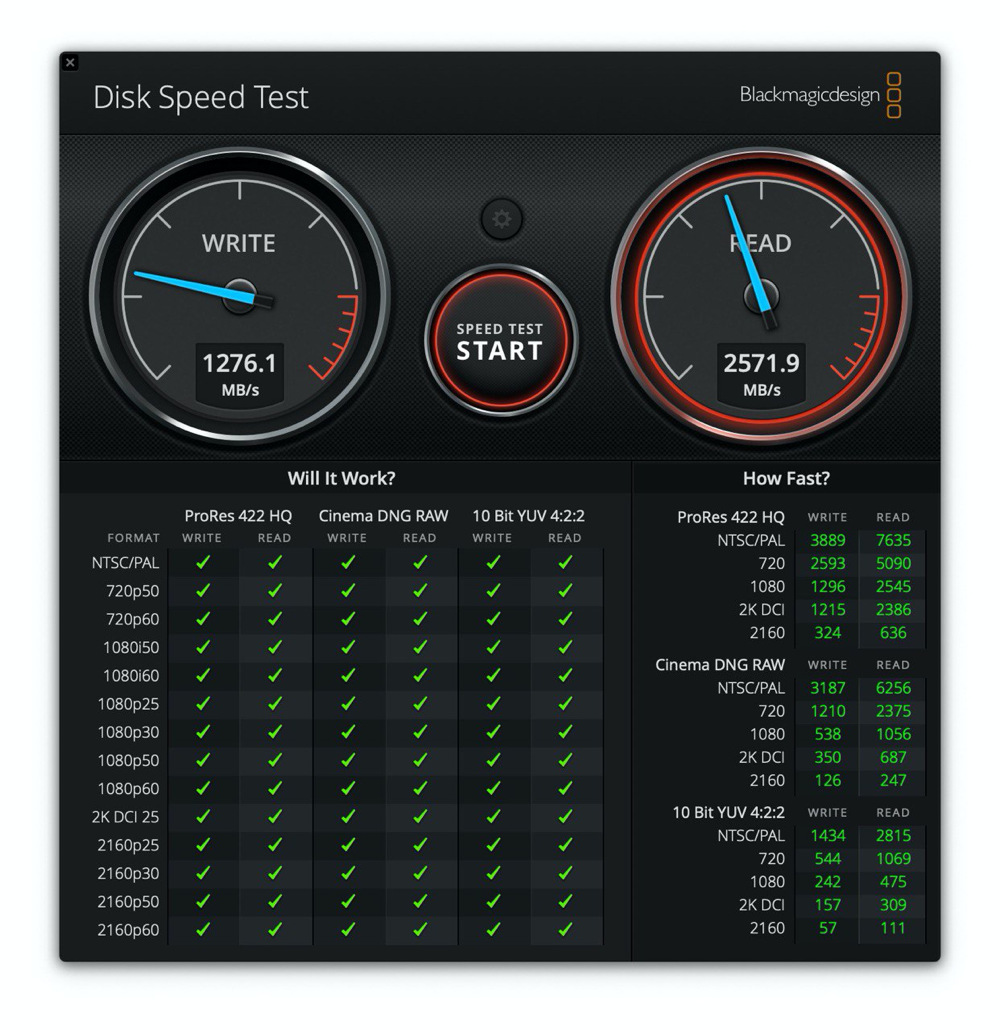
We wondered why his machine would be so much slower in write speed and he found some articles suggesting that write speeds on bigger disks are actually faster. We’re going to need to dig deep to figure this one out. I used a lot of sources including a live chat with my little friend Evan over at OWC, and a great video by Techquickie, reading a viewer discussion on howtogeek.com/… and some quality time spent on Wikipedia.
First of all, quite a while ago, Apple started using NVMe chips in their SSDs. NVMe is the express version of NVM. NVM stands for Non-volatile Memory, which is often NAND flash memory. Wait for it, NAND isn’t actually an acronym, it stands for NOT AND, a boolean operator and logic gage. Before our heads explode, just remember the word NAND.
In our Mac (and other computers), the SSDs are made up of multiple NAND memory chips, not just one. Bigger SSDs have more NAND chips. And every NAND chip has its own controller. As Evan from OWC put it, “We can think of the controller of each drive as a pair of hands, since it controls and maneuvers the flow of data on the storage blocks or platters of a drive. When you have more hands doing the same work … then you have more performance.”
There’s one piece missing from this explanation. We understand that bigger disks have more NAND memory chips so more controllers so they’re faster, but in Steven and my comparisons of the two different drive sizes, the bigger one was only faster on write. On read speeds, the 256GB SSD was nearly as fast as the 4TB. When comparing my 2TB and 4TB SSDs from 2016 and 2019, I see dramatic increases in both read and write.
If anyone knows why both of these results make sense, I’d love to know.
Audio
Let’s shift gears to talk about audio. I promised that I could draw a line between the 16″ MacBook Pro and the SpaceX tour and that time has come. I don’t promise it’s a straight line, but let’s see if we can follow the path.
Apple is evidently serious about audio now, having just named Gary Geaves to a new Vice President of acoustics role. They have made dramatic improvements in both the speakers and the internal microphone on the new 16″ MacBook Pro.
I’ll play you a little audio file here comparing my Heil PR-40 studio mic to the internal mic on the 16″ MacBook Pro.
I know it’s not AS good as the Heil (I’d be bummed if it was) but if you get this Mac and want to do a recording for the show using the internal mic, it is well up to the task of producing a good sound.
I can’t play the speakers for you, because that would make no sense, but they do sound really good for internal laptop speakers. When Steve was in college, he moved into his dorm room in his freshman year and was excited to set up his stereo system. The first thing he played was the new hit “More Than a Feeling” by Boston. Ever since then it’s been his tradition to test all speakers and headphones with the same song. We fired it up on the new MacBook Pro and the 2016, and the difference was definitely noticeable. The new Mac had substantially better bass response.
They improved the bass response by using force-canceling subwoofers. You probably know that the subwoofer is where you hear the bass, with the treble in the tweeter, but what do they mean by force-cancelling subwoofers? This is where my background will really nerd things up. I’m going to explain what that means.
How a speaker works
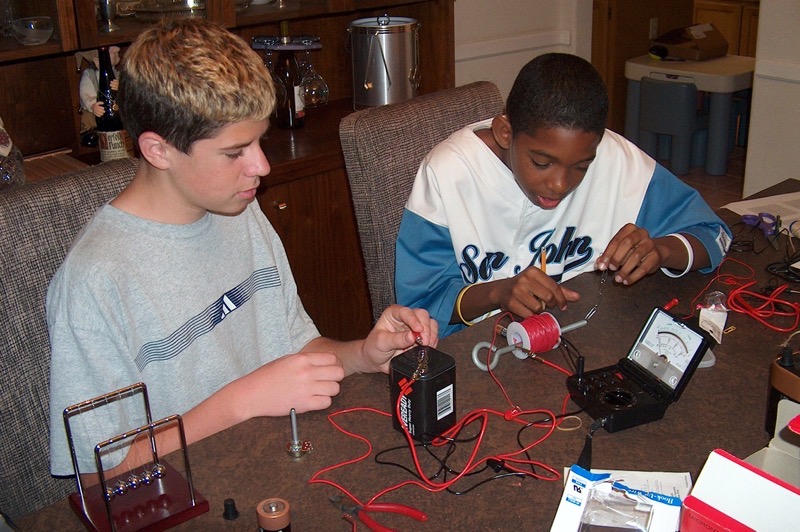
I’ll start by explaining the basics of electromagnetism. If you coil a wire, and pass an electric current through it, you’ll create a magnetic field. The more turns you put in the coil, the more powerful the magnetic field. Now if you put a magnetic rod into the center of the coil, you can actually move the magnetic rod by changing the current in the coil. You can actually do this at home. It’s one of Steve’s favorite things to teach young kids.
Now that you know you can move a magnetic rod with a coil of wire, you’re ready to learn how speakers work. Speakers have a magnet sitting inside a coil of wire, the combination of which is called a voice coil actuator. Applying current across the wire coil will cause the magnet to move. There’s a thin, flexible, cone-shaped membrane attached to the magnet. When electric current is run through the coil, the magnet moves, which deflects the conic membrane and moves air with it. The air moving becomes sound to your ear. Now isn’t that just cool?
Force-cancelling
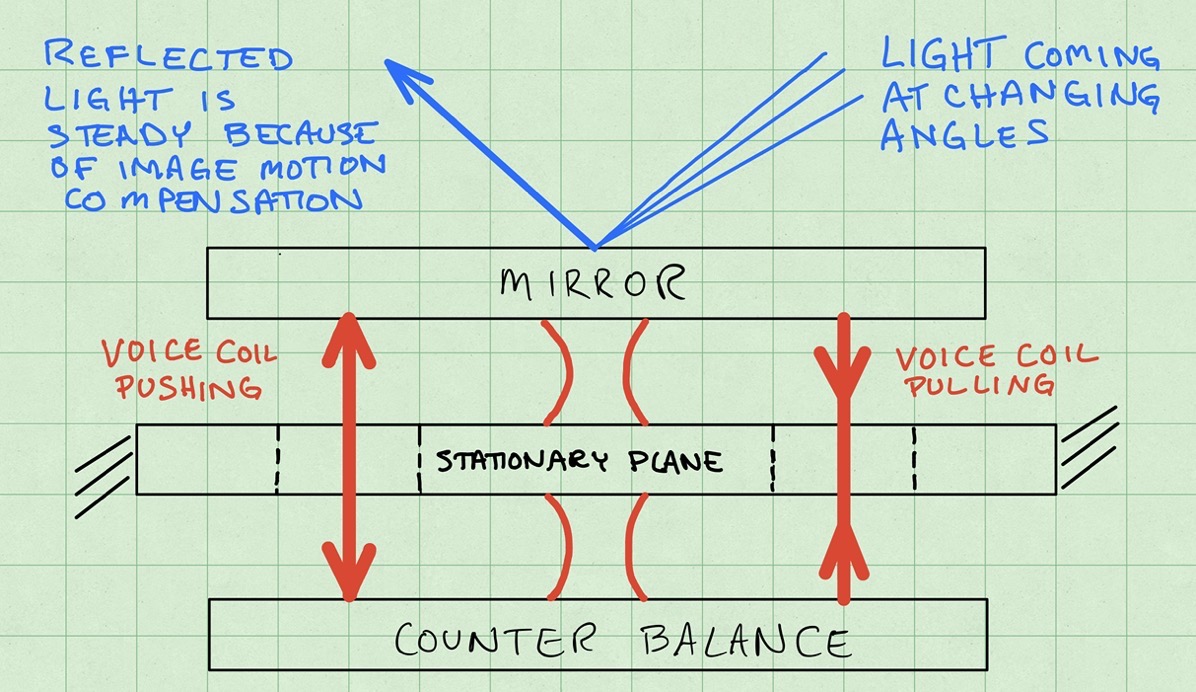
Inside a laptop, moving these voice coil actuators back and forth to make sound come out of the speakers works just fine, but the force that this puts on the case and other components causes vibrations. Those vibrations also come out as sound to your ears. Basically the case can start rattling and make for an unpleasant experience.
I promised a connection to SpaceX, right? On the tour, we saw them laying out carbon fiber, and I said it reminded me of the optical bench I worked on a hundred years ago. While I didn’t design the optical bench itself, I was responsible for a tiny little device called an image motion compensation (IMC) mirror. The purpose of my mirror was to compensate for vibrations in the image reflecting off of it. The overall project, called the Helicopter Night Vision System, allowed a helicopter pilot to wear a heads-up display to view infrared imagery wherever she looked so she could fly at night and see everything clearly.
It turns out that pilots can stand movement of an image up and down or right to left. But the way the optical train worked, any vibrations caused a twist of the imagery, and that makes the pilot urpy. We needed my little IMC mirror to save the pilot.
Gyroscopes on the platform measured how much motion I had to remove. The simplest way to do this would be to mount the mirror on the optical bench by a flexible pivot, and then use voice coil actuators to move it in two axes to compensate for the motion from the gyros. But just like the speakers in the MacBooks, pushing that mirror with the voice coil actuators would introduce new forces against the optical bench. With a goal of eliminating movement, that’s the last thing we wanted. I needed a way to not introduce those forces when I moved my mirror.
Imagine the optical bench is just a ground plane that’s not going to move. We’ve got the mirror mounted parallel to the top of this plane by the flex pivot. On the underside of the ground plane, I mounted a piece of aluminum of the same distributed mass of the mirror by an identical flex pivot. So we’ve got the mirror connected to the ground plane by a flex pivot, and then underneath there’s an identical-sized metal plate connected by an identical flex pivot. I drew a picture for the show notes using Notability on my iPad with Pencil if your’e confused about what I’ve described.
Now here’s the tricky part. We drilled holes in the plane to which these two pieces are mounted and mounted the magnet half of a voice coil to the lower piece, and the coil half to the mirror up above. In this way, when we applied current through the voice coil, the mirror and the lower plate would move in opposite directions by bending their respective flex pivots. The result was that no linear forces were applied to the optical bench, so we introduced no vibrations with my little mirror. For the super nerdy, yes, this introduced some torque on the mount point of the flex pivots but it wouldn’t cause vibrations.
Apple didn’t do anything quite as complex as all this, but instead, they mounted two voice coils back to back, with the same signal going to each one. When one moves in one direction, the other pushes back in the opposite direction, canceling out the vibrations that would be introduced into the case and other parts of the laptop.
See? I told you I could draw a line from SpaceX to the audio system on the MacBook Pro! I bet you no one else gave this explanation of the 16″ MacBook Pro,
Bottom Line
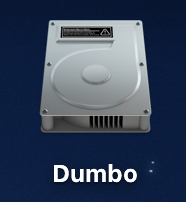 The bottom line is that I think this laptop will serve me for the next 3 years, most importantly handling with ease the enormous demand I put on it for the live show. You should expect buttery smooth video from now on.
The bottom line is that I think this laptop will serve me for the next 3 years, most importantly handling with ease the enormous demand I put on it for the live show. You should expect buttery smooth video from now on.
I mentioned last week I needed a name for my new hard drive. Last week I asked if anyone could remember the name of my 1TB drive. In our Slack group (podfeet.com/slack) Marc and Nuclear Jon both remembered it as 2013 as Fatso, which triggered my memory that it was actually Phatty (with a ph). I can’t believe they both remembered that! My 2TB drive in the 2016 is named Hippo. Marc and Jon discussed options for my 4TB drive. They considered Rhino and Elephant but wanted to leave room for growth in the future. Pat nailed it though – she suggested Dumbo. Get it? An elephant, but a baby elephant, so room for growth in the future. Dumbo it is.

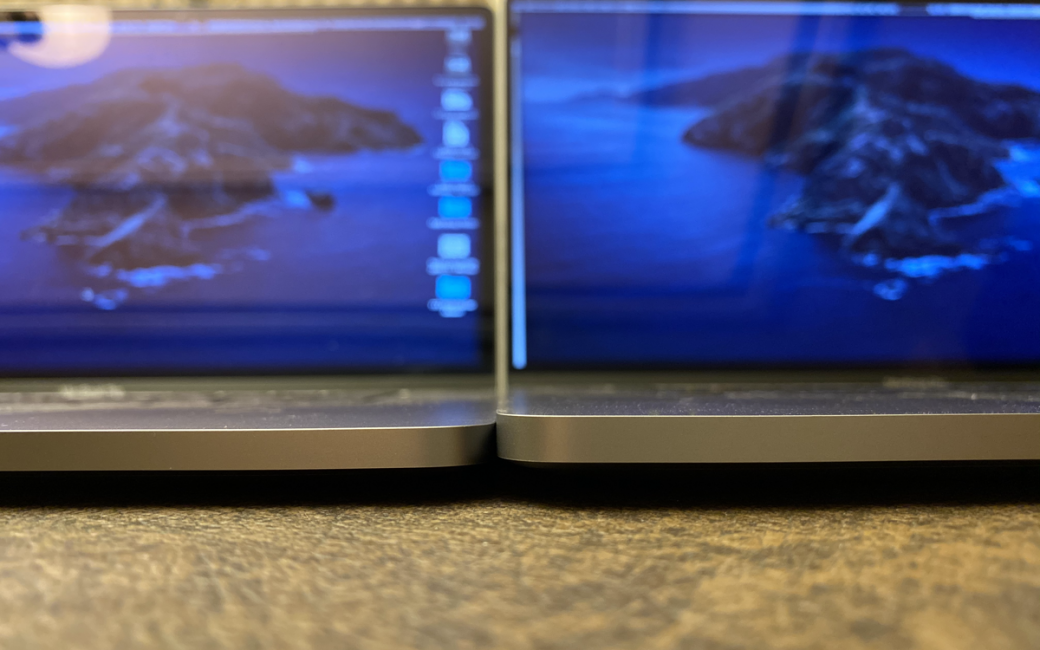
Allison — You wrote ”But his write speed is 57% slower. This is where things get really interesting and will take us down a geeky path that will mystify David Roth.” How did you know about David Roth?
We’re probably not talking about the same David Roth. David is a good friend of mine in real life and listens to the podcast, and always gives me a hard time if there’s math involved, hence my poking fun at him here.